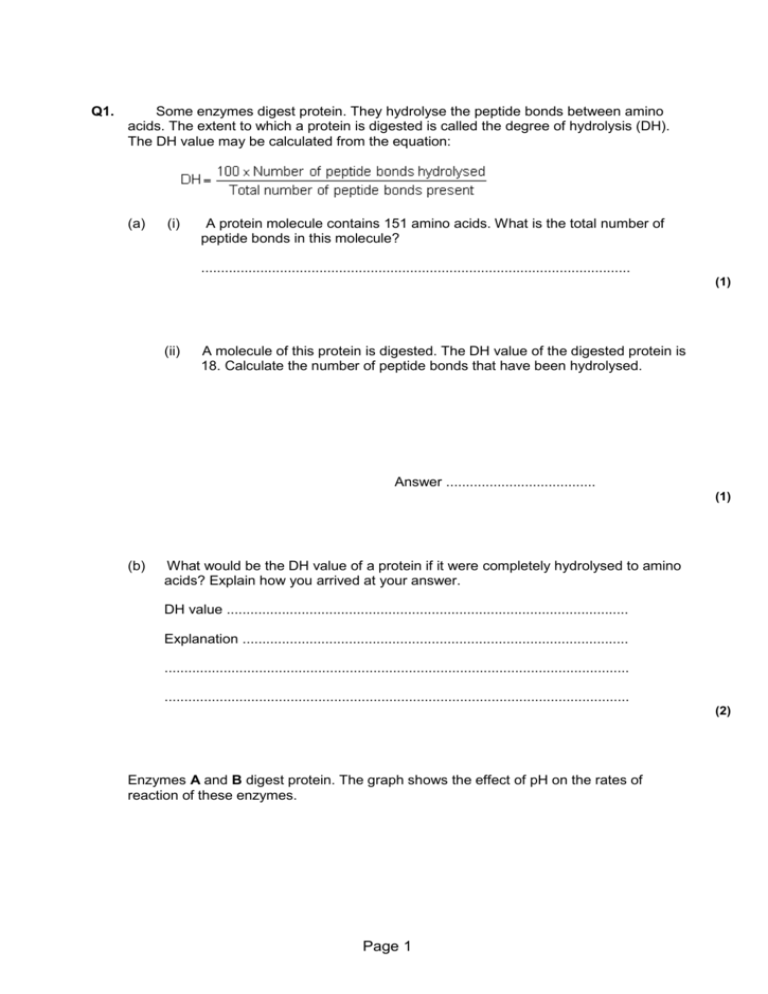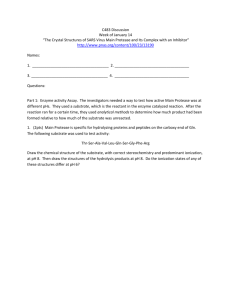Proteins exam questions and markscheme
advertisement

Q1. Some enzymes digest protein. They hydrolyse the peptide bonds between amino acids. The extent to which a protein is digested is called the degree of hydrolysis (DH). The DH value may be calculated from the equation: (a) (i) A protein molecule contains 151 amino acids. What is the total number of peptide bonds in this molecule? ............................................................................................................. (1) (ii) A molecule of this protein is digested. The DH value of the digested protein is 18. Calculate the number of peptide bonds that have been hydrolysed. Answer ...................................... (1) (b) What would be the DH value of a protein if it were completely hydrolysed to amino acids? Explain how you arrived at your answer. DH value ...................................................................................................... Explanation .................................................................................................. ...................................................................................................................... ...................................................................................................................... (2) Enzymes A and B digest protein. The graph shows the effect of pH on the rates of reaction of these enzymes. Page 1 (c) Pepsin is a protein-digesting enzyme found in the stomach. It has an optimum pH of 2 and is fully denatured at pH 6. Sketch a curve on the graph to show the effect of pH on the rate of reaction of pepsin. (1) (d) Explain why the rate of reaction of enzyme B is low at pH 5. ...................................................................................................................... ...................................................................................................................... ...................................................................................................................... ...................................................................................................................... ...................................................................................................................... ...................................................................................................................... (3) (e) Enzyme A is present in some washing powders used for cleaning clothes. Use the graph to suggest why enzyme A would be of more use in washing clothes than enzyme B. ...................................................................................................................... ...................................................................................................................... ...................................................................................................................... (1) Page 2 (f) Use your knowledge of protein structure to explain why enzymes are specific and may be affected by non-competitive inhibitors. ...................................................................................................................... ...................................................................................................................... ...................................................................................................................... ...................................................................................................................... ...................................................................................................................... ...................................................................................................................... ...................................................................................................................... ...................................................................................................................... ...................................................................................................................... ...................................................................................................................... ...................................................................................................................... ...................................................................................................................... ...................................................................................................................... ...................................................................................................................... (6) (Total 15 marks) Q2. Read the following passage. During the course of a day, we come into contact with many poisonous substances. These include industrial and household chemicals. The skin acts as a barrier and prevents many of these substances entering and harming the body. 5 The skin is one of the largest organs in the body. It is composed of several layers of tissue. The outer layer consists of dead cells packed with keratins. Keratins are a group of proteins that differ from each other in their primary structure. Each keratin molecule consists of several polypeptide chains, each individual chain wound into a spiral or helix. The polypeptide chains include many sulphur-containing amino acids and these help to give the keratin molecules their characteristic strength. Page 3 Use information from the passage and your own knowledge to answer the questions. (a) What is the evidence from the passage that keratin molecules have a quaternary structure? ...................................................................................................................... ...................................................................................................................... (1) (b) Explain how sulphur-containing amino acids help to give keratin molecules their characteristic strength (lines 8–9). ...................................................................................................................... ...................................................................................................................... ...................................................................................................................... ...................................................................................................................... (2) (c) Explain why differences in primary structure result in keratins with different properties (line 6). ...................................................................................................................... ...................................................................................................................... ...................................................................................................................... ...................................................................................................................... (2) (d) The skin prevents poisonous substances entering and harming the body (line 3). Explain why these substances are unable to pass through the outer layer of skin cells by active transport. ...................................................................................................................... ...................................................................................................................... ...................................................................................................................... ...................................................................................................................... ......................................................................................................................(3) (Total 8 marks) Page 4 M1. (a) (i) 150; 1 (ii) 27; 1 (b) 100; number of peptide bond hydrolysed = total number present / all peptide bonds have been hydrolysed; accept calculation showing same number top and bottom. 2 (c) curve rising to peak at pH 2 and falling to zero by pH 6; 1 (d) (change in pH) leads to breaking of bonds holding tertiary structure / changes charge on amino acids; enzyme/protein/active site loses shape/denatured; substrate will not bind with/fit active site; fewer/no ES complexes formed; 3 max (e) more resistant to changes in pH and washing conditions variable/ works in alkaline pH and washing powders alkaline; mark awarded for indicating aspect of effect of pH and advantage of this in terms of washing powder and conditions in wash. 1 (f) maximum of three marks for specificity, points 1 - 4. Can only be given credit in context of specificity 1 each enzyme/protein has specific primary structure / amino acid sequence; 2 folds in a particular way/ has particular tertiary structure; 3 active site with unique structure; 4 shape of active site complementary to/ will only fit that of substrate; maximum of three marks for inhibition, points 5 – 8 5 inhibitor fits at site on the enzyme other than active site; 6 determined by shape; 7 distorts active site; 8 so substrate will no longer fit / form enzyme-substrate complex; Page 5 6 max [15] M2. (a) Several/more than one polypeptide chain in molecule; Evidence must only relate to 4º structure 1 (b) Chemical bonds formed between sulphur-containing groups/ R-groups/form disulphide bonds; Stronger bonds; Bind chain(s) to each other; max 2 (c) Different number of amino acids; Different sequence of amino acids; Bonds in different places; Gives different shape; max 2 (d) Outer layer of skin cells are dead; Do not respire/Do not contain mitochondria; Do not produce ATP/release energy; Cells do not have required proteins/carriers; max 3 [8] Page 6 E1. (a) It was encouraging to note the many candidates who clearly understood the unfamiliar biology presented in parts (a) and (b) and were able to gain maximum credit. In part (a), the difficulty for many was determining the number of hydrogen bonds present. It was evident from some answers that there was much confusion with DNA, particularly with those responses that involved multiplying by two or dividing by three. (b) Most candidates explained, often with considerable clarity, that all bonds would be broken with complete hydrolysis. Many were also able to derive the correct answer. (c) Most candidates sketched an appropriate curve on the graph. (d) Answers to part (d) gave cause for some concern. Many candidates offered a bullet-pointed list often involving an increase in kinetic energy, faster movement and more frequent collisions between enzyme and substrate. This suggested that they had done little more than set out a standard response to a temperature-related problem. Answers to this question reinforced the view expressed by many examiners, that many candidates see learning of past mark schemes as an effective substitute for understanding the relevant biological principles. Where attempts were made to explain how a low pH would affect the rate of the enzyme concerned, answers were often disappointingly superficial with answers such as that “the enzyme works more efficiently at a greater pH and so at pH 5 it is not working at its fastest” being typical. (e) While most candidates successfully linked this part of the question to enzyme activity over a greater pH range, few took their answers to the required level and related this to washing conditions. (f) The main difficulty experienced by candidates in attempting this part of the question was in tailoring responses to fit the theme of specificity. Thus, there were many descriptions of protein molecules and enzyme action which failed to comment on the uniqueness of either primary or tertiary structure. Non-competitive inhibition was described much better, although examiners were of the opinion that the facts cited by candidates were not always supported by genuine understanding. Encouragingly, there were few candidates who confused competitive and non-competitive inhibition although rather more were uncertain as to the location of the active site and frequently assigned this to the substrate. Page 7 E2. (a) Difficulties were experienced with this question where answers were frequently unselective, relating not only to quaternary structure but to aspects of secondary and tertiary structure as well. To gain credit here, candidates needed to confine their answers to the fact that keratin molecules consisted of several polypeptide chains. (b) Most candidates clearly appreciated that the bonds formed between sulphurcontaining amino acids were strong and helped to bind the individual polypeptide chains. Less able candidates often confused these bonds with peptide bonds or did little more than paraphrase the wording of the question. (c) As was not infrequently the case with the answers to many of the questions in this paper, less able candidates gave the impression of relying on the recall of mark schemes from broadly similar past questions. In this case they either simply described the primary structure of a protein, which gained little credit, or described how the primary structure of a protein affected its tertiary structure which was potentially, at least, a better option. Those who read the question carefully were usually able to comment on differences in the amino acid sequence leading to differences in bonding and in molecular shape. There was some confusion, presumably among candidates who had also completed Module 2 or 3, between amino acids, proteins and bases. (d) As in part (c), the principal requirement here was to answer the question as written. Unfortunately, the response offered by many was no more than a description of active transport. In this question candidates were expected to use this knowledge along with information available in the passage to explain why substances were unable to pass through the outer layer of skin cells. Those who approached the question in the right way generally pointed out that the cells were dead and progressed to make an appropriate comment about respiration and the release of energy or generation of ATP. A not infrequent misconception was that since movement against a concentration gradient involves active transport, active transport cannot be involved in movement down a gradient. Page 8









